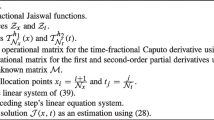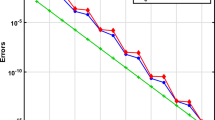Abstract
In this paper we present an analysis of a numerical method for a degenerate partial differential equation, called the Black–Scholes equation, governing American and European option pricing. The method is based on a fitted finite volume spatial discretization and an implicit time stepping technique. The analysis is performed within the framework of the vertical method of lines, where the spatial discretization is formulated as a Petrov–Galerkin finite element method with each basis function of the trial space being determined by a set of two-point boundary value problems. We establish the stability and an error bound for the solutions of the fully discretized system. Numerical results are presented to validate the theoretical results.
Similar content being viewed by others
References
Achdou Y. (2005). An inverse problem for a parabolic variational inequality arising in volatility calibration with American options. SIAM J. Control Optim. 43(5): 1583–1615
Allegretto W., Lin Y. and Yang H. (2001). Finite element error estimates for a nonlocal problem in American option valuation. SIAM J. Numer. Anal. 39(3): 834–857 (electronic)
Angermann L. (1995). Error estimates for the finite-element solution of an elliptic singularly perturbed problem. IMA J. Num. Anal. 15: 161–196
Angermann L. and Wang S. (2003). Three-dimensional exponentially fitted conforming tetrahedral finite elements for the semiconductor continuity equations. Appl. Numer. Math. 46: 19–43
Barles G. (1997). Convergence of numerical schemes for degenerate parabolic equations arising in finance theory. In: Rogers, L.C.G. and Taley, D. (eds) Numerical Methods in Finance, pp 1–21. Cambridge University Press, Cambridge
Barles G., Daher Ch. and Romano M. (1995). Convergence of numerical schemes for problems arising in finance theory. Math. Models Methods Appl. Sci. 5: 125–143
Bensoussan, A., Lions, J.-L.: Applications of variational inequalities in stochastic control. In: Studies in Mathematics and its Applications. vol. 12, North-Holland Publishing Co., Amsterdam (1982) Translated from the French
Benth F.E., Karlsen K.H. and Reikvam K. (2004). A semilinear Black and Scholes partial differential equation for valuing American options: approximate solutions and convergence. Interfaces Free Bound. 6(4): 379–404
Black F. and Scholes M. (1973). The pricing of options and corporate liabilities. J. Polit. Econ. 81: 637–659
Courtadon G. (1882). A more accurate finite difference approximation for the valuation of options. J. Financ. Econ. Quant. Anal. 17: 697–703
Cox J.C., Ross S. and Rubinstein M. (1979). Option pricing: a simplified approach. J. Financ. Econ. 7: 229–264
Forsyth P.A. and Vetzal K.R. (2002). Quadratic convergence for valuing American options using a penalty method. SIAM J. Sci. Comput. 23(6): 2095–2122 (electronic)
Glowinski R. (1984). Numerical Methods for Nonlinear Variational Problems. Springer, Berlin Heidelberg New York
Han H. and Wu X. (2003). A fast numerical method for the Black–Scholes equation of American options. SIAM J. Numer. Anal. 41(6): 2081–2095
Haslinger, J., Miettinen, M., Panagiotopoulos, P.D.: Finite element method for hemivariational inequalities. In: Nonconvex Optimization and its Applications, vol. 35, Kluwer, Dordrecht (1999)
Holtz, M., Kunoth, A.: B-spline-based monotone multigrid methods (2004) (Submitted)
Hull J.C. and White A. (1988). The use of control variate technique in option pricing. J. Financ. Econ. Quant. Anal. 23: 237–251
Hull J.C. and White A. (1996). Hull-White on Derivatives. Risk Publications, London
Jaillet P., Lamberton D. and Lapeyre B. (1990). Variational inequalities and the pricing of American options. Acta Appl. Math. 21(3): 263–289
Kinderlehrer, D., Stampacchia, G.: An Introduction to Variational Inequalities and Their Applications. Academic New York, (1980)
Kufner A. (1985). Weighted Sobolev spaces. Wiley, New York Translated from the Czech
Miller J.J.H. and Wang S. (1994). A new non-conforming Petrov-Galerkin method with triangular elements for a singularly perturbed advection-diffusion problem. IMA J. Numer. Anal. 14: 257–276
Miller J.J.H. and Wang S. (1994). An exponentially fitted finite element volume method for the numerical solution of 2D unsteady incompressible flow problems. J. Comput. Phys. 115: 56–64
Oosterlee, C.W.: On multigrid for linear complementarity problems with application to American-style options. Electron. Trans. Numer. Anal. 15, 165–185 (electronic) (2003). In: 10th Copper mountain conference on multigrid methods (Copper Mountain, CO, 2001)
Ortega J.M. and Rheinboldt W.C. (1970). Iterative Solution of Nonlinear Equations in Several Variables. Academic Press, New York
Rogers L.C.G. and Tallay D. (1997). Numerical Methods in Finance. Cambridge University Press, Cambridge
Schwartz E. (1977). The valuation of warrants: implementing a new approach. J. Financ. Econ. 13: 79–93
Vázquez C. (1998). An upwind numerical approach for an American and European option pricing model. Appl. Math. Comput. 97(2–3): 273–286
Wang S. (2004). A novel fitted finite volume method for the Black–Scholes equation governing option pricing. IMA J. Numer. Anal. 24: 699–720
Wang S., Yang X.Q. and Teo K.L. (2006). A power penalty method for a linear complementarity problem arising from American option valuation. J. Optimz. Theory App. 129(2): 227–254
Wilmott P., Dewynne J. and Howison S. (1993). Option Pricing: Mathematical Models and Computation. Oxford Financial Press, Oxford
Zvan R., Forsyth P.A. and Vetzal K.R. (1998). Penalty methods for American options with stochastic volatility. J. Comput. Appl. Math. 91(2): 199–218
Author information
Authors and Affiliations
Corresponding author
Rights and permissions
About this article
Cite this article
Angermann, L., Wang, S. Convergence of a fitted finite volume method for the penalized Black–Scholes equation governing European and American Option pricing. Numer. Math. 106, 1–40 (2007). https://doi.org/10.1007/s00211-006-0057-7
Received:
Revised:
Published:
Issue Date:
DOI: https://doi.org/10.1007/s00211-006-0057-7




